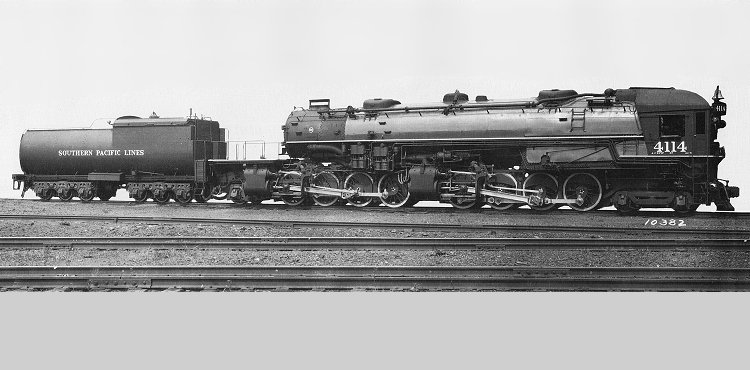The Southern Pacific was the only North American railroad to operate steam locomotives in the cab-forward configuration (not counting tank engines in suburban service on the Boston & Albany, Jersey Central, and Canadian National which also regularly ran cab-forward). The principal reason for the SP's use of the cab-forward locomotive was the presence of snow sheds on the main line over the Sierras. Operating a large locomotive through this area could result in near-asphyxiation of the enginemen from the exhaust of a stack ahead of the cab; reversing the engine so the stack was at the rear alleviated this problem. The cab-forward design, applied to several articulated types, burned fuel oil piped along the engine's length from the tender to the firebox at five pounds pressure to ensure constant flow. The designation "AC" the SP applied to most of these locomotives stood originally for "Articulated Consolidation," since earlier examples were of the 2-8-8-2 wheel arrangement.
The preponderant type of SP cab-forward was the 4-8-8-2 of which there were 195, all Baldwin-built between 1928 and 1944. They were not 2-8-8-4 "Yellowstones" in reverse; the four-wheel pilot truck under the cab was really only a more stable substitution for the original two-wheel trailing truck of a 2-8-8-2. These engines were not restricted to the snowshed-dotted route over Donner Pass, but also operated in other parts of the SP system. Despite their relatively low 63½-inch drivers they were capable of passenger-train speeds when needed in that service.
Cab-forward No. 4114, shown here in a Baldwin builder's photo, was a member of the AC-5 group delivered in 1929. Dimensions of this class were similar to those shown for No. 4173 of the AC-7 class, except that boiler pressure was 235 p.s.i., tractive effort was 116,000 pounds, and engine weight was 614,600 pounds. Notice that the Walschaerts valve gear on these locomotives had the "inverse" configuration with the eccentric crank angled away from the cylinders, but because the engine was intended to run cab-forward the radius rod was in the lower position.
